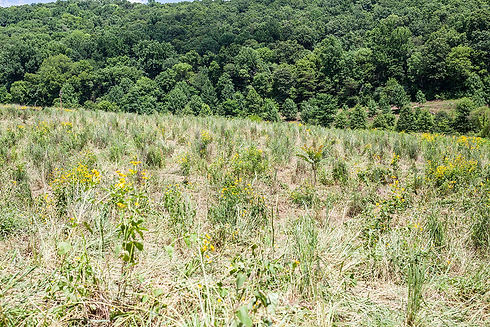
Why Grassfed?
We feature only 100% grass-fed lamb and beef. Traditionally, sheep and cattle in the United States are raised with one guiding principle: get the animals fat as quickly as possible. After being born on pasture, young “stockers” are moved to feedlots where they are fed corn and soybeans, often exclusively. Corn is a carbohydrate, which helps create fat and marbling in the meat. Think of feed corn as candy for livestock. Soybeans are the protein source that helps add weight fast. Think of soybeans as livestock protein shake. There's only one problem, sheep and cattle aren't supposed to be eating 'candy' and 'protein shakes', they're not designed to digest corn and soybeans.
Sheep and cattle are ruminant animals. They have a four-chambered stomach. The first part, the rumen, is essentially a large fermentation vat that holds the grass and forage and allows enzymes and bacteria to help break down cellulose (plant based fibers), which allows the digestive tract to extract more nutrients. The remaining parts are a series of muscles that further process the forage, similar to a true stomach. So by nature, cattle and sheep are designed to live entirely off of grass. And Mother Nature gives us sunshine, rain, grass and even weeds. With patience and dedication to our pasture programs, we can fatten cattle entirely on grass – a more healthy and sustainable approach.


Before

After
A grass-fed diet isn't just better for our livestock, it is also a tool for slowing climate change. Every day our animals are moved to a new patch of grass that has had a minimum 30 day rest period since its last been grazed. Instead of having to feed our flherd every morning we have to set the next line of temporary fencing and pull the old. We concentrate our livestock's grazing. This intense grazing, concentrated manure, and hoof traffic combined with long rest periods helps to build healthy fields. Intense grazing kills invasive weeds our livestock would otherwise skip over, the concentrated manure of animals fertilizes the soil, and finally the heavy foot traffic breaks up the ground helping its fertilization. An extended rest period promotes a healthy replenishing of our fields with a diversity of plant species. As a result our paddocks are never bare. We don't have problems with erosion, and we never fertilize or mow our fields. We are developing rich grasslands that capture CO2, reducing carbon in the atmosphere is critical to bringing down global temperatures.

Higher levels of omega-3 fatty acids
Not only does grass fed lamb and beef contain much higher levels of omega-3s than conventional lamb and beef, it also contains an ideal ratio of omega-3 to omega-6 fatty acids which is vital in helping control and reduce inflammation.

Elevated levels of Conjugated Linoleic Acid (CLA)
100% grass fed lamb and beef is one of the best sources of CLA. CLA exerts potent antioxidant activity. Studies have documented CLA’s ability to prevent diseases like cancer, diabetes and heart disease.

More vitamins and minerals
100% grass fed lamb and beef contains more calcium, magnesium, potassium, zinc, phosphorus, beta-carotene and iron than feedlot lamb and beef.
It also has higher levels of B vitamins – specifically (thiamin (B1) and riboflavin (B2), as well as the fat soluble vitamins A, D, E and K. These fat soluble vitamins enhance mineral and protein absorption and are believed to protect against cardiovascular disease.

Elevated concentrations of Glutathione
Glutathione is often called the body's "master antioxidant. It is a very powerful antioxidant that helps protect the body from oxidation and DNA damage.
